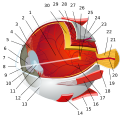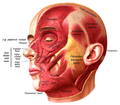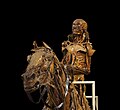Portal:Anatomy
Introduction
Anatomy (from Ancient Greek ἀνατομή (anatomḗ) 'dissection') is the branch of morphology concerned with the study of the internal structure of organisms and their parts. Anatomy is a branch of natural science that deals with the structural organization of living things. It is an old science, having its beginnings in prehistoric times. Anatomy is inherently tied to developmental biology, embryology, comparative anatomy, evolutionary biology, and phylogeny, as these are the processes by which anatomy is generated, both over immediate and long-term timescales. Anatomy and physiology, which study the structure and function of organisms and their parts respectively, make a natural pair of related disciplines, and are often studied together. Human anatomy is one of the essential basic sciences that are applied in medicine, and is often studied alongside physiology.
Anatomy is a complex and dynamic field that is constantly evolving as new discoveries are made. In recent years, there has been a significant increase in the use of advanced imaging techniques, such as MRI and CT scans, which allow for more detailed and accurate visualizations of the body's structures.
The discipline of anatomy is divided into macroscopic and microscopic parts. Macroscopic anatomy, or gross anatomy, is the examination of an animal's body parts using unaided eyesight. Gross anatomy also includes the branch of superficial anatomy. Microscopic anatomy involves the use of optical instruments in the study of the tissues of various structures, known as histology, and also in the study of cells. (Full article...)
Selected general anatomy article
Gray's Anatomy is a reference book of human anatomy written by Henry Gray, illustrated by Henry Vandyke Carter and first published in London in 1858. It has had multiple revised editions and the current edition, the 42nd (October 2020), remains a standard reference, often considered "the doctors' bible".
Earlier editions were called Anatomy: Descriptive and Surgical, Anatomy of the Human Body and Gray's Anatomy: Descriptive and Applied, but the book's name is commonly shortened to, and later editions are titled, Gray's Anatomy. The book is widely regarded as an extremely influential work on the subject. (Full article...)
Selected anatomical feature
A nostril (or naris /ˈnɛərɪs/, pl.: nares /ˈnɛəriːz/) is either of the two orifices of the nose. They enable the entry and exit of air and other gasses through the nasal cavities. In birds and mammals, they contain branched bones or cartilages called turbinates, whose function is to warm air on inhalation and remove moisture on exhalation. Fish do not breathe through noses, but they do have two small holes used for smelling, which can also be referred to as nostrils (with the exception of Cyclostomi, which have just one nostril).
In humans, the nasal cycle is the normal ultradian cycle of each nostril's blood vessels becoming engorged in swelling, then shrinking.
The nostrils are separated by the septum. The septum can sometimes be deviated, causing one nostril to appear larger than the other. With extreme damage to the septum and columella, the two nostrils are no longer separated and form a single larger external opening. (Full article...)
Selected organ
Splanchnic is usually used to describe organs in the abdominal cavity.
It is used when describing:
- Splanchnic tissue
- Splanchnic organs - including the stomach, small intestine, large intestine, pancreas, spleen, liver, and may also include the kidney.
- Splanchnic nerves
- Splanchnic mesoderm
- Splanchnic circulation – the circulation of the gastrointestinal tract originating at the celiac trunk, the superior mesenteric artery and the inferior mesenteric artery. (Full article...)
Selected biography
William Harvey (1 April 1578 – 3 June 1657) was an English physician who made influential contributions in anatomy and physiology. He was the first known physician to describe completely, and in detail, the systemic circulation and properties of blood being pumped to the brain and the rest of the body by the heart, though earlier writers, such as Realdo Colombo, Michael Servetus, and Jacques Dubois, had provided precursors of the theory. (Full article...)
Selected images
Categories
WikiProjects
Some Wikipedians have formed a project to better organize information in articles related to Anatomy. This page and its subpages contain their suggestions; it is hoped that this project will help to focus the efforts of other Wikipedians. If you would like to help, please swing by the talk page.
WikiProject Anatomy update
| new good articles since last newsletter include Thyroid, Hypoglossal nerve, Axillary arch, Human brain, Cerebrospinal fluid, Accessory nerve, Gallbladder, and Interventricular foramina (neuroanatomy) | |
| There is Introduction to Anatomy on Wikipedia published in the Journal of Anatomy [1] | |
| We reach two projects goals of 20 good articles, and less than half of our articles as stubs, in July 2017. Wikipedia talk:WikiProject Anatomy/Archive 11#Congratulations to all | |
| A discussion about two preferred section titles takes place here. |
Things to do
- Participate in discussions - a number of discussions such as those on our talk page or about our infobox would benefit from your opinion!
- Continue to add content to our articles
- Collaborate and discuss with other editors - many hands make light work!
- Help us simplify our anatomy articles
- Improve and update existing articles (lists of articles needing improvement)
- Example missing articles: Wikipedia:Requested articles/list of missing anatomy
- Reduce the number of stubs
Topics
Related portals
Wikimedia
The following Wikimedia Foundation sister projects provide more on this subject:
-
Commons
Free media repository -
Wikibooks
Free textbooks and manuals -
Wikidata
Free knowledge base -
Wikinews
Free-content news -
Wikiquote
Collection of quotations -
Wikisource
Free-content library -
Wikiversity
Free learning tools -
Wiktionary
Dictionary and thesaurus


















